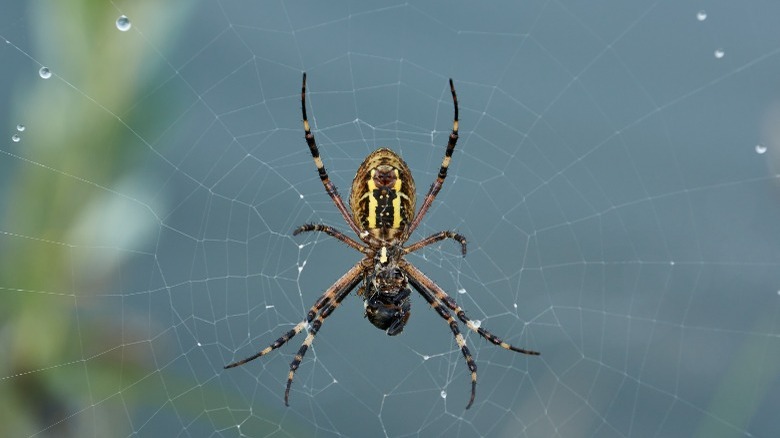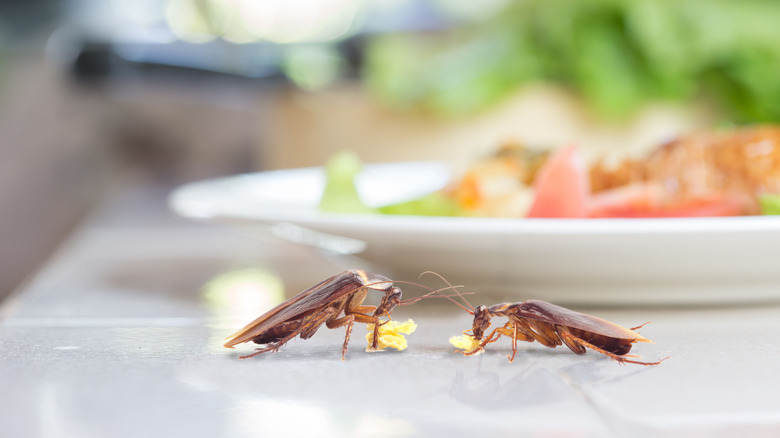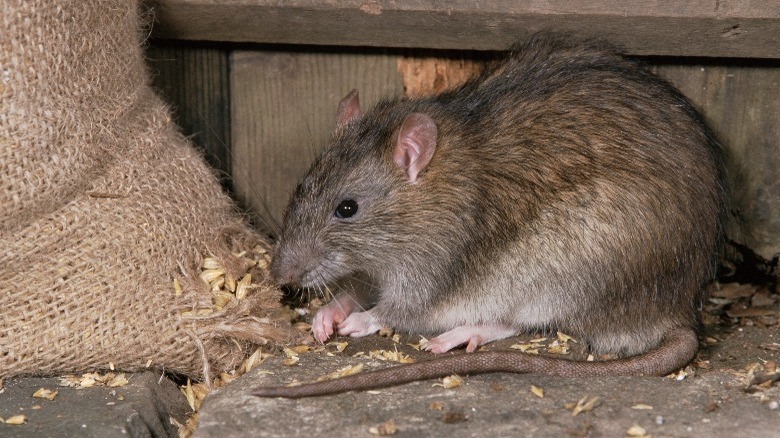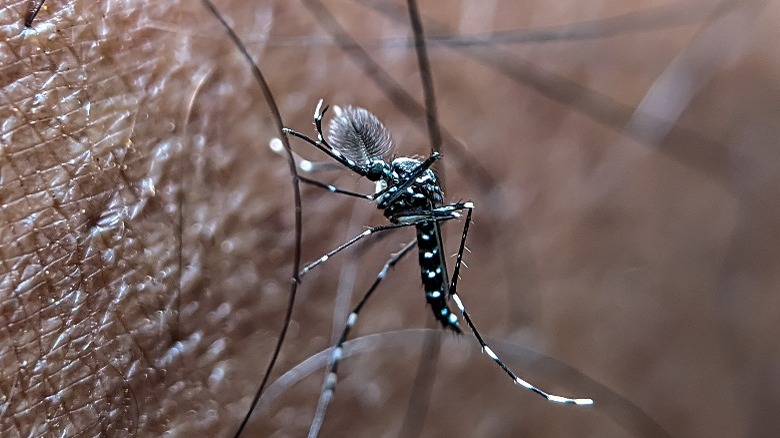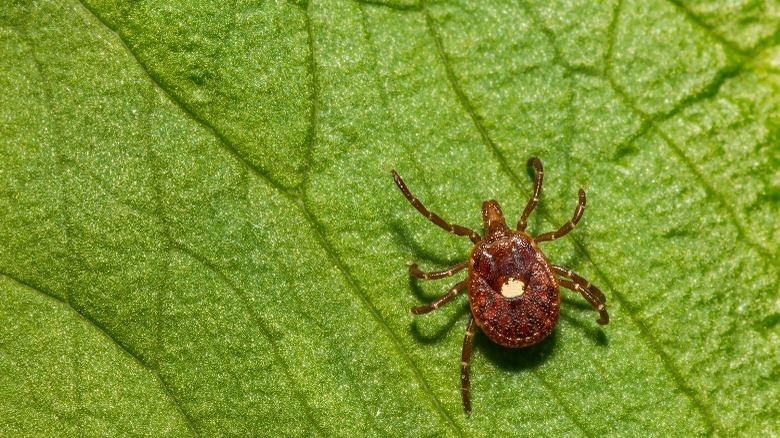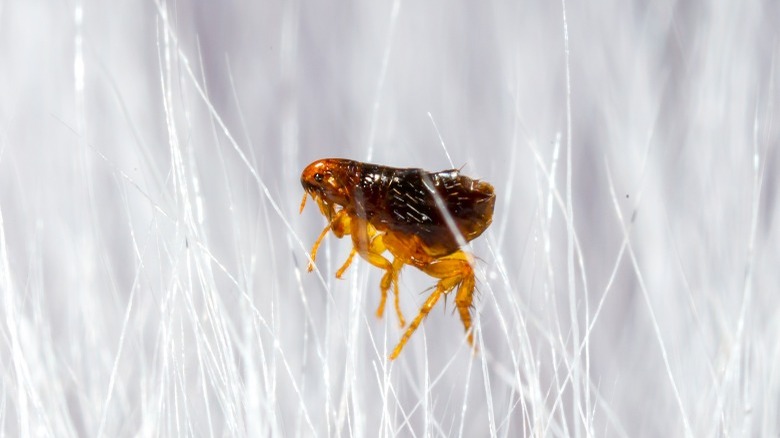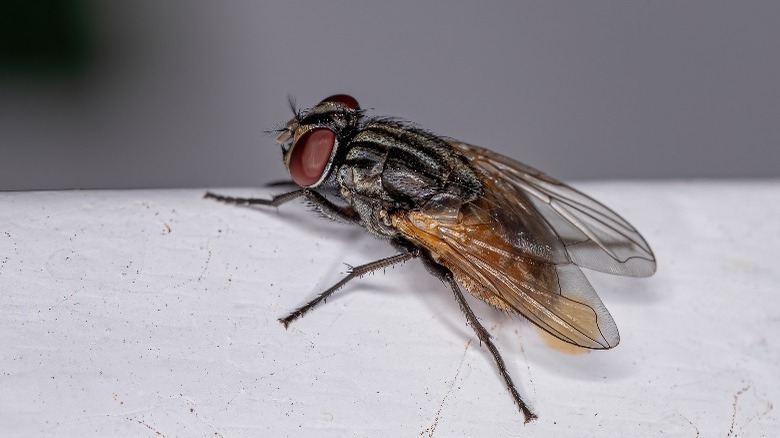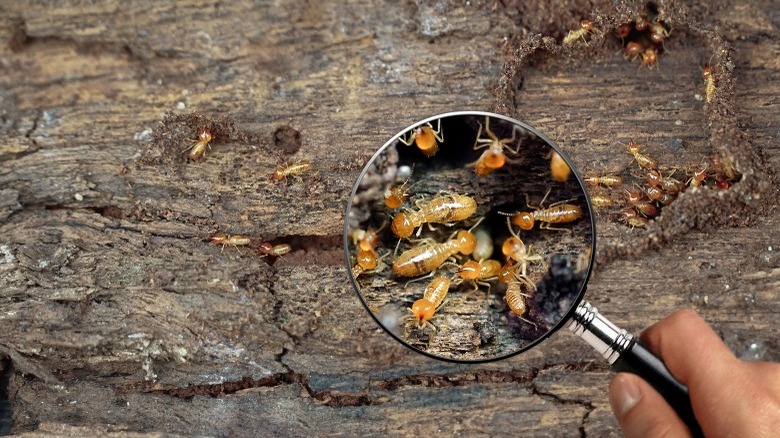Myths About Pest Control You Need To Stop Believing Now
If we look at Merriam-Webster's definition of a myth, it's described as a popular belief based on unproven assumptions. But while this simple explanation of the word captures the essence, the nuances are harder to convey. For instance, the fact that arguably most myths are founded in some truth, or people's insistence on believing and spreading certain myths more than others. There are literally thousands of myths out there concerning the pests we try to control, so we decided to tackle them pest by pest. We've tracked down some of the more common ones and some of the most unusual ones, and one thing is practically guaranteed; you'll come away with knowledge you didn't have before.
For example, whoever came up with putting cheese in mouse traps? Victor Pest Control says that perhaps if a mouse is starving, it may go for cheese, but this is not, by far, the rodent's favorite food. Instead, they suggest using foods like peanut butter, cookies, chocolate, or even pet food in your traps. Or have you ever heard that fleas would die without a host? According to FleaScience, this is technically a myth, although partially true. If you take away the host from fleas that are attached and feeding, they can only last about four days before they will starve. However, the life cycle of a flea is complex, and the adult fleas still in their cocoon (ready to emerge) will go into a dormant stage if there's no blood host around. They can live for up to 155 days without sustenance, and can sense warm blood when it's within reach. Read on to learn more common myths about pest control.
Myths about bees
According to Noble Research Institute, a couple of common myths about bees need to be dispelled. The first is that a bee can only sting once. This only applies to honeybees, so bumble bees, killer bees, wasps, and hornets can sting more than once. Therefore, if you're allergic like me, or just paranoid about getting stung twice, take cover! Assume you're dealing with a bee or wasp that can sting multiple times and stay away from the area completely. Call a professional for help.
The second common myth is that bees only sting if provoked. Though partially true, you may only need to get too close to their nest to provoke them. If you're unaware of where that might be, this could prove easier than you think, especially for a child. Additionally, another commonly held misconception is that bees won't sting at night, but they will sting whenever they feel threatened, no matter what the clock says. You might have also heard that you should seal up a hole in your house where bees are nesting, but this will only anger the bees inside. They can actually burrow through and end up inside your home instead!
Myths about spiders
We've all heard tons of myths about these eight-legged creatures, right? For the truth, we're going straight to the experts at Burke Museum, which tackles such myths such as always being within 3 feet of a spider, or people swallowing spiders in their sleep. Both of these, you'll be glad to know, are false. Neither of these myths has any basis in fact, even though both have been repeated incessantly. But that's not all — spiders get a bad rap. Did you know most house spiders are non-poisonous and would likely not survive outdoors? There are natural methods of repelling spiders, such as spraying peppermint oil or vinegar in hiding places, according to Smith's Pest Management.
Or how about the one saying Daddy Longlegs have highly poisonous venom if they had fangs big enough to bite us? It turns out this is a complete fairytale, with zero basis in fact! Of the types typically called Daddy Longlegs, most have no venom, and one has weak poison. Here's a crazy myth about something called camel spiders (in Iraq). Rumor has it they're 1 foot long, can run up to 25 miles per hour screaming like a banshee, devour the flesh of large mammals, and lay their eggs in camels. This one sounds crazy, but people swear by it, including soldiers. The truth is, according to National Geographic, they're about 6 inches long, their top speed is more like 10 miles per hour, and they are not deadly to humans, although their bite is painful. They actually do make a barely audible sound, like a mixture between a buzz and a hiss. Somehow, none of that is much of a consolation.
Myths about cockroaches
To help us separate the truth from the myths about cockroaches, the National Institute of Environmental Health Sciences tells us these pests don't differentiate between dirty or clean homes. They are looking for easy access to food and water; therefore, if food and crumbs are lying around, that's where they'll go first. Many people think they live extremely long lives, but the reality is they live anywhere from a couple of months to a couple of years.
One common myth people love to repeat is that they can withstand a nuclear blast. Apparently, they can withstand 10 times the radiation you or I could handle, but they couldn't make it through World War III. That's a relief. However, a roach can also survive for more than a month with no food, and yes, they do carry diseases and eat nearly anything. Pest control is necessary to eliminate roaches, according to Orkin, because roach eggs, in particular, are resistant to most household products.
Myths about mice and rats
Victor Pest Control helps bust myths concerning rats and mice, like the one that says they're harmless. This could not be further from the truth, as both carry terrible diseases that can be fatal to humans and are easily transmitted (via King County). They will also bite when cornered, so beware! The diseases they carry can be spread through the saliva, urine, feces, and food supplies they get into. Do not touch mouse or rat droppings with your bare hands; disinfect the entire area if you find any evidence of them. Another myth is that your problem is solved if you suspect a mouse or rat and catch it in a mousetrap. While this may be true in some cases, realistically, there are probably more. Mice and rats reproduce quickly and often, and there's likely a family somewhere.
Mice and rats only forage about 30 feet from their home, but they usually build their nests close to where they know there's a food source. Additionally, Cannon Pest Management describes how their teeth never stop growing, thus the constant need to gnaw and chew through, well, just about anything. However, Cannon dispels the myth that rodents can't swim. In fact, if you flush a rat or a mouse down the toilet, it can swim back up through the pipes! Oh, and did I mention parasites? Besides carrying diseases, they also carry parasites. Aside from a pro, Terminix says traps are the best pest control for mice and rats.
Myths about bed bugs
My mother always said, " Goodnight, don't let the bed bugs bite." As kids, we don't think they're real, but as adults, we realize they can be a real nightmare. From Panther Pest Control, we know that it's sometimes difficult to detect an infestation because bed bugs are excellent at hiding in any little crack or seam, and they typically don't come out to feed until we're fast asleep. Not only that, but the bites themselves are painless. This is because bed bugs are equipped with built-in anesthesia in their saliva that numbs the area first and increases the blood flow while feeding. They typically sleep within a couple of feet of their host and are attracted to the warmth of our bodies and the carbon dioxide we breathe out while sleeping.
However, don't believe they're limited to nesting in your bed, as most people think. They can live anywhere, including electrical outlets, behind pictures on the wall, or in cracks in the baseboards. Another common myth is that they can fly or jump, which they cannot. And one of the most common pest control myths is that bed bugs can be killed with pesticides. Yoy need to stop believing this one because bed bugs have become resistant to the pesticides that once were effective. Today's best method is widely known to be heat treatment, which can be expensive but is the only solution guaranteed to eliminate an infestation. According to Angi, the average cost is $2,000 to $4,000. Incidentally, their bites are harmless unless you're allergic, and though they itch like the dickens, they don't carry diseases.
Myths about mosquitoes
According to the American Mosquito Control Association, mosquitoes are no joke. These pests are more than just harmless nuisances; they carry several serious diseases easily transmitted to humans, dogs, and horses. Some of these are malaria, heartworm disease, yellow fever, equine encephalitis, and the West Nile virus. Over a million people across the globe die every year from mosquito-transmitted diseases, posing a severe threat. So it's important to know what's a myth and what's a fact.
Mosquito Joe reports it's a myth that they die after biting humans. In fact, only female mosquitoes bite, and they use the blood they extract for protein in their egg development. It's also a myth that if you eat certain foods, you're either tastier or more disgusting to mosquitoes. However, certain factors do attract mosquitos more. if you're an O blood type, you might look like a walking (raw) hamburger. Jonathan Day, a professor of medical entomology at the University of Florida, told NBC News that sweat, pregnant women, the colors dark red, navy blue, and black, and those who have a high metabolism also attract these pests at a higher rate. Consumer Reports gives some good advice on staying bite-free, including mesh screens on open windows or doors, using a fan outside, eliminating standing water immediately, and using a safe, effective repellent.
Myths about ticks
If you have pets, one of the most annoying problems is keeping them free from ticks. According to Tickipedia, only two species can transmit Lyme disease to humans: black-legged ticks and deer ticks. It takes them 24 hours to fully release the bacteria, so finding and removing them as soon as possible is important. It's also a myth that you'll get what looks like a red bullseye around the bite if you have it. While it is a common telltale sign, the bullseye can appear anywhere on the body. However, only about 20% of people with Lyme disease show this sign.
But this doesn't mean you only have to worry about those two particular species. All species can carry harmful diseases, and can be a serious nuisance to your pets. It is not advised to kill them with Vaseline, a hot match, or nail polish. WebMD says to use pointed tweezers to grasp it by the head and pull it straight up and out slowly. Then, you can drown it in rubbing alcohol or flush it down the toilet. Do not use your bare hands or nails to squish ticks to death. Ticks can be as tiny as a grain of salt or as big as a fingernail when fully engorged. However, it's a myth if you don't get the head, it can still transmit disease and continue to suck blood. Some people even think ticks can regrow their bodies! Thankfully, this is a myth. Your body will eventually expel the tick head on its own, but disinfect the area with rubbing alcohol to prevent infection.
Myths about fleas
For myths about fleas, Mosquito Joe reports it's a myth that they can fly. Fleas, in fact, cannot fly, but they can jump like an olympian up to 1 foot! It's also not true that they die or go away in the winter. The truth is, although they aren't really active outdoors during the coldest months, they can seek shelter in your home or on other people's pets, which your pet might interact with. Fleas are pretty hardy and can find shelter and lie dormant if outdoors. Another common belief is that you're safe if you find a couple of fleas on your pet and immediately remove them. Female fleas can lay a whopping 50 eggs a day, and there are several stages in their life cycle. As a matter of fact, at least 90% of any flea population is unseen, as it's in pre-adult stages and not even on your pet!
According to Vetstreet, garlic is not a remedy that works for repelling fleas, either. In fact, ingesting enough garlic can cause a serious or even deadly case of anemia by damaging red blood cells in pets. In addition, it's not true that fleas don't carry diseases, because they do. Fleas carry things like cat scratch fever (yep, it's a real thing!) and tapeworms, among other diseases and parasites. Additionally, any home can be a great one as far as fleas are concerned. They don't discriminate between dirty or clean, carpeted or not, and preventative measures are the most effective. Once you have them, they're more challenging to eliminate. For best results, be vigilant about your pet's flea treatments each month.
Myths about flies
When it comes to flies, it gets pretty repulsive. One of the common myths is that they vomit every time they land, which is disturbing at the least. According to Western Exterminator, when a fly wants to eat something in solid form, it first must turn it into a liquid. How does it do this? Though it sounds horrible to us, flies are equipped with powerful digestive juices that can break down their food quickly, so they must vomit these juices onto their food first. So it's a myth that they puke every time they land — they only do so when they land on something they want to eat.
Another common myth is that flies only live for 24 hours. Ehrlich helps us debunk this myth, explaining that their average lifespan is 20 to 25 days, and cases have been reported for up to two months. Another fly myth that's been going around for quite some time now says Ziploc baggies with water and a few pennies keep flies away. Supposedly, if you hang these bags around your house, it is an effective pest control for flies. According to HowStuffWorks, there's no scientific reason why this method works, but there is a theory. Too many people swear it works miracles to discount it, so it's believed to have something to do with light fracturing off the water and the pennies, throwing off their sensitive "flysight." In any case, it's worth a shot!
Myths about termites
Foundation Pest Control tells us these home invaders are hard to spot, so the myth that an infestation is obvious is debunked. In fact, by the time you spot any damage, it's likely too late to stop an infestation. This is because termites burrow underground to get to wood and often gnaw from the inside out. This is why termite inspections are recommended yearly, and preventative measures should be taken. Plus, if you ever want to sell your house, nothing kills a sale like finding termites during the home inspection. Another common termite myth is that they're not active in the winter. Unfortunately, this is not accurate. Wintertime only makes them burrow deeper in the wood, causing more damage. Incidentally, most pest control places offer free inspections.
Another termite myth is that if a home is treated once, it doesn't need treatment again. This is a common mistake you'll want to avoid. You also need to understand that DIY methods are not likely to be effective against them. These pests are like bed bugs in this area, meaning some bug infestations are impossible to eliminate without professional help. And just in case you were wondering, where do bugs get on the train? Why, at the infestation, of course!


